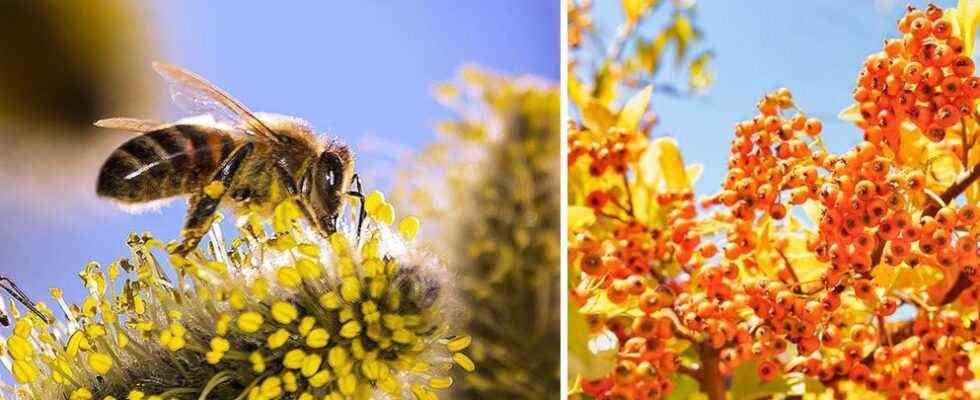What is a honey plant?
Honey plants are the plants that produce nectar that is highly prized by bees and from which they make their honey. However, not all flowers secrete it. Only 10% of plants are affected.
A honey plant will be able to produce either:
- the nectar which is used for making honey;
- pollen which is used for the production of royal jelly;
- propolis which serves as a mortar and anti-infectious substance;
- honeydew which is a complement to the nectar.
Trees and shrubs then have a certain propensity to produce nectar and pollen which is calculated in kilograms per hectare. You can choose them according to this rating or opt for plantations that will provide food in spring and autumn. Whether in town or in the countryside, we have the possibility of increasing the park of honey plants intended for bee nutrition. You can opt for trees, shrubs or flowers. If you have very little outdoor space, if at all, you can also put flower pots on the windows.
Lavender

When it comes to honey plants, it’s impossible not to think of lavender. It is an evergreen shrub that finds its place in all gardens even in rather stony soil. Its only requirement is to be in full sun. From spring, it adorns itself with blue-purple floral spikes which are the delight of bees. It is a hardy and robust plant that does not fear heat or cold.
Lilac

This shrub is not the most melliferous, but it will still be able to feed the bees while bringing a pleasant scent to your garden. Its incredible flowering extends between April and May. Reserve it a location in the sun, preferably to make the most of its flowering or, possibly, in partial shade. It prefers a neutral, rather rich or calcareous soil. In adulthood, it measures between 2 and 6 m high. It is a hardy shrub and easy to grow.
Dogwood

Very easy to grow, this shrub is covered with yellow inflorescences. Flowering can take place from February until June, depending on the variety chosen. Also depending on its variety, your shrub may prefer a rich and acidic or poor and calcareous soil. For its location, it likes a sunny position, but sheltered from the rays of the scorching sun, or in partial shade. It is rather rustic.
Symphorine

This deciduous shrub is easy to grow and very hardy. It is covered with a white or pink bloom rich in nectar, from July to September. Then small red berries take place until the heart of winter, to the delight of the birds. It is very tolerant and adapts to all types of soil and exposure.
Photinia

Photinia is widely used for creating hedges, for example. In addition to being hardy, it is easy to grow. At the very beginning of spring, it is covered with white inflorescences and is then the delight of bees. Its green and red foliage is evergreen and allows you to enjoy it throughout the year. It thrives in all types of soil and whatever the exposure.
Hawthorn

This thorny shrub is covered at the end of spring with a white or pink bloom which gives off a pleasant scent. Hawthorn is very hardy and hardy. Undemanding, it can be planted in all drained and deep soils. It prefers sunny locations and requires very little maintenance.
Willow marsault

At adult size, this small tree generally reaches between 5 and 10 m in height. Its flowering is quite early since it begins in February and extends until April. At the end of winter, it therefore constitutes a considerable help for the bees. In addition to the marsault willow, you can also opt for a weeping willow. Rustic, it can withstand temperatures down to -15 ° C. It thrives in normal, cool soil. For optimal development, choose a sunny or partial shade exposure.
Chaste tree

Also called “pepper tree”, this bushy shrub blooms profusely during the summer. It is vigorous and resistant to cold. You can set it up in full sun in cool soil. It tolerates calcareous soil and drought. In any case, he has a very marked preference for draining soils.
Pyracantha

This bushy shrub is covered with thorns, but also with a fragrant bloom that will delight foragers, then decorative berries that will serve as food for birds. In addition, it is persistent and retains its interest throughout the year. Prefer a sunny location or with light shade. It thrives in neutral, fertile and draining soil. It is rustic and withstands temperatures down to -20 ° C.
Medlar

At adult size, this fruit shrub measures between 4 and 6 m high. It thrives in rather rich, well-drained soil. Fallen into disuse, it is nevertheless a very good ally of bees. Its white flowering takes place between May and June and produces delicious fruits, medlars, in autumn. It is very resistant to cold and finds its place in any region of France. It should be planted in a sunny location or in partial shade.
Ceanothe

This shrub needs sun or light shade to provide beautiful blue flowers from April to June that attract bees. Installed sheltered from the wind, it resists temperatures down to -10 ° C. Persistent, you will enjoy it throughout the year. It thrives in rich, light and well-drained soil.
Privet

This rustic shrub finds its place everywhere in France and can be used as a hedge, in a bed or planted in isolation. Undemanding, it still appreciates a cool, well-drained soil, as well as a location in the sun or in partial shade. Be sure to protect it from dry winds, however. Its flowering takes place in summer between June and August to the delight of the bees. In addition, it is easy to grow.

